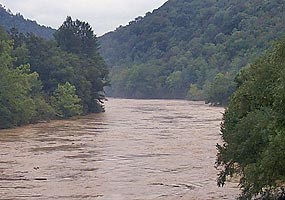The following are descriptions at various water levels of the Clear Fork and Big South Fork Rivers from Brewster Bridge (Highway 52) to Leatherwood Ford Bridge (State Route 297). Gauge readings are from the Leatherwood Ford gauge. These descriptions were provided by four whitewater clubs in 1989 and are generalized statements about conditions that may be experienced while running the gorge.
These descriptions are meant as an aid to help you use your own judgment in deciding if you should run this section of the river. Because of changes in the river over time, these descriptions may not be accurate. Use them as a guide, but scout each rapid before you try it.
500 (CFS): This level is considered very low. The rapids, especially on Clear Fork, are extremely technical. Broaching on rocks due to the tight passages is likely. Bottoming out in the vertical drops is common. Rapids, especially in the main gorge, are steep and rocky. Pinning is possible. River classification: Class III with one or two Class IV’s.
1000 CFS: This level is considered optimum for open canoes. Rapids remain technical and rocky. Several drops are still very vertical. Waves grow to 2-4 feet in height in places. Canoe swamping is possible. River classification: Class III with a few Class IV’s.
1800 CFS: Clear Fork becomes much less technical and sports several Class III rapids. The main gorge begins to have big water at this level, with several waves topping out at 4-5 feet. Vertical drops still exist at Double Falls, Washing Machine, and The Ell (The Big Three), as well as two drops in the canyon. The Big Three section is solid Class IV. Rescue between drops becomes problematic at this level, and some rapids, e.g., Krekels (Honey Creek Rapid), are continuous for over 1/4 mile. River classification: Class III-IV.
2500 CFS: The river maintains a similar character at this level, with waves reaching 6 feet in heights. Some holes become very tenacious at this level, particularly those at The Ell, Rion’s Eddy, and the Canyon. Overall difficulty is Class III - IV with several strong Class IV’s.
3500 CFS: Clear Fork rapids become nearly continuous at this level. Water in the Little Three rapids is powerful, with reactionary waves beginning to form in the 6 foot range. The main gorge is Class IV and very powerful. Waves in the 6 foot range are common, with several waves up to 8 feet. Swirly water and whirlpools begin forming at the bottoms of rapids at this level. Rescue becomes very difficult because of the swiftness of the water, and the length and difficulty of the rapids.
5000 CFS: At this level, the river changes character. Waves in the 6-8 foot category are common, with a few attaining 10 feet in height. Some eddies are very unstable, and waves begin to pulse. Diagonal reactionary waves are common in the gorge and make upright boating continuously difficult. Equipment is frequently lost if not retrieved expeditiously. River classification: Class IV.

